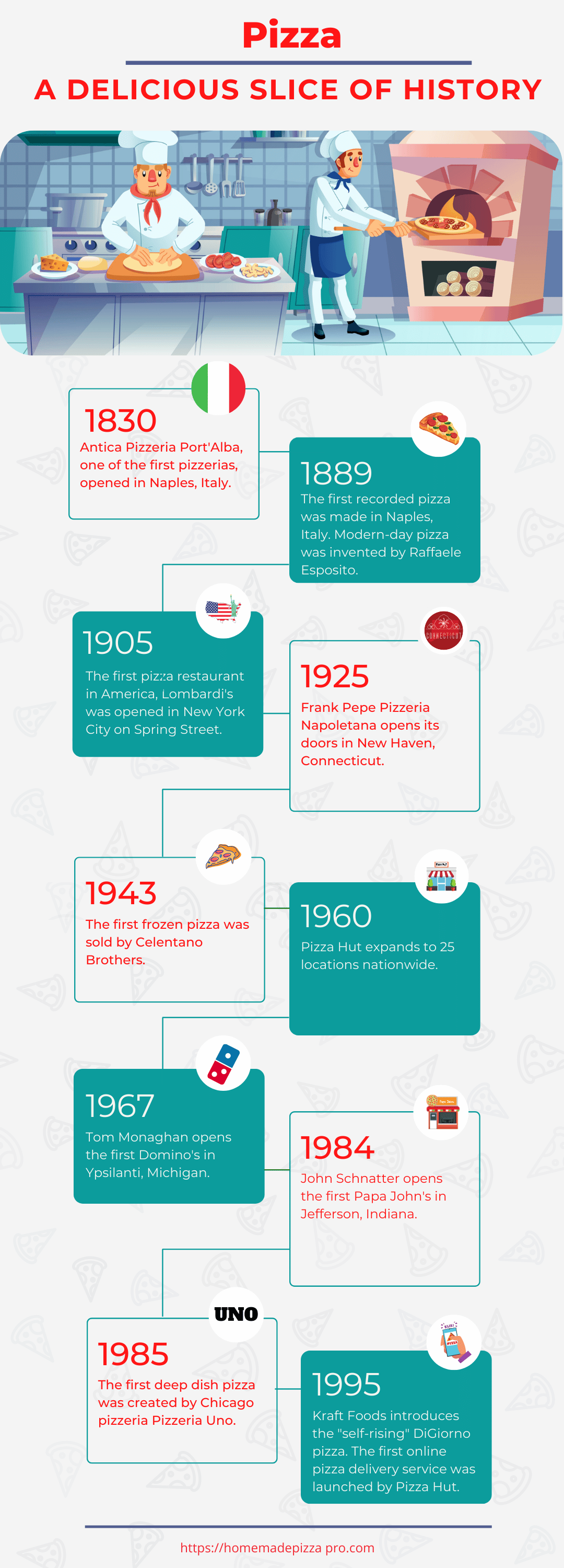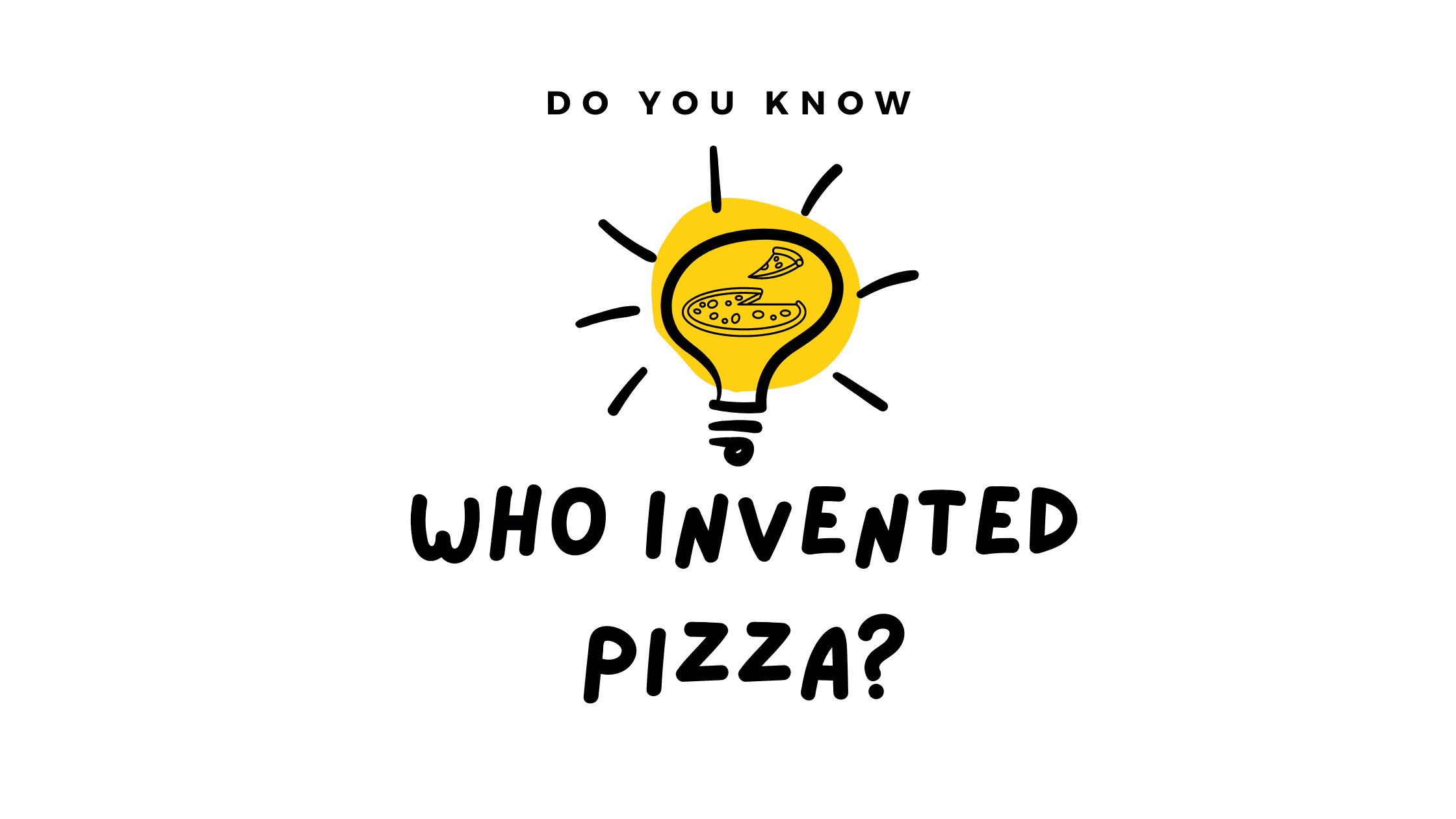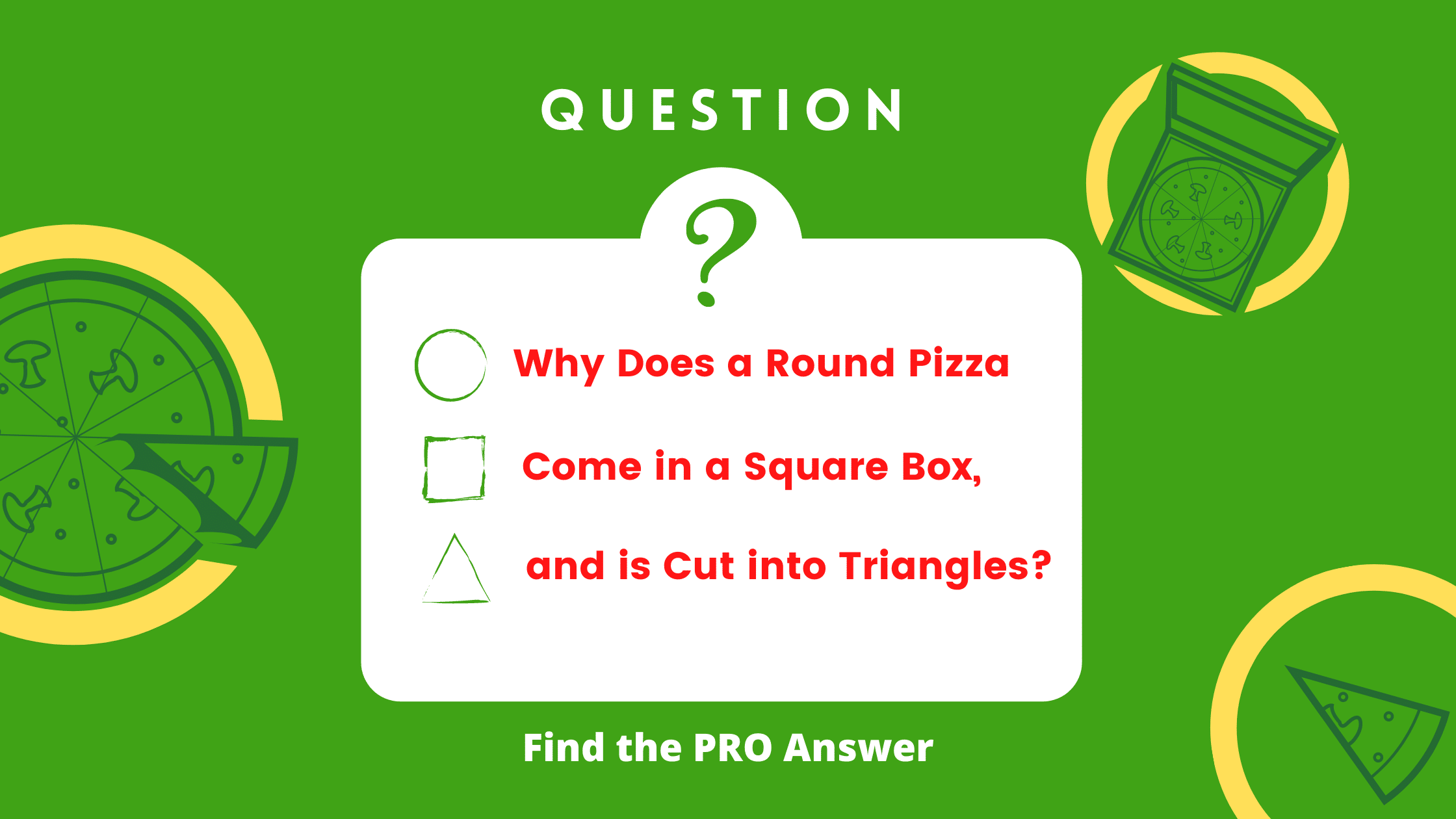If you are looking for the cheesier history of pizza, then we have all the knead-to-know facts.
From its 1889 inception in Naples, Italy, to Pizza Hut’s expansion into 100 different countries around the globe, we are here to bring you a Chicago deep dish filled with all of your favorite toppings and fun facts.
Let’s dig in.
Here’s What You Will Find:
Ancient Origins
The genesis of pizza can be traced back to several ancient cultures that relished simple flatbreads with toppings. These were not the same as the modern pizza we enjoy today but certainly represent a rudimentary form of it.
This practice was ubiquitous and cut across different civilizations, indicating that the idea of topping bread with various ingredients was a fundamental and intuitive culinary practice.
Specific examples include the ancient Egyptians and the Greeks. The Egyptians had a custom of celebrating the Pharaoh’s birthday with a flatbread seasoned with herbs, which can be considered a primordial form of pizza.
The Greeks, too, had their version of flatbread, which they topped with olive oil and local spices. The Greek settlers in the city of Naples, Italy, introduced their “pita” bread to the Italians, a key step towards the evolution of pizza as we know it. These early examples set the stage for developing the more recognizable form of pizza in later centuries.
What is the True Origin of Pizza?
There has been a lot of debate over where pizza indeed originated from.
There was a belief that it was brought over to the United States following the Second World War because the U.S. troops grew fond of the local delicacy.
But is that the pizza’s origin story?
No, not entirely.
Pizza as we know it was actually invented in Naples, Italy, at the end of the 19th century. It was an affordable and tasty way for the working class to fill their stomachs.
And while it is true that U.S. soldiers fell in love with the dish while they were stationed in Italy during World War II, it’s not the whole story.
For the origins of the pizza, we need to travel back to ancient Egypt, where flatbread was consumed regularly.

But something was missing. Sure, you could eat the flatbread by itself, but it tasted better if you could dip it in something flavorful or spread some topping on top of it to make it more delicious.
By 1889 the original Egyptian flatbread had been morphed into something magnificent.
Naples was a bustling Italian city filled with working-class people at the time. They didn’t have time to spend all day cooking their meals.
Instead, they always looked for the quickest way to feed their family.
Esposito filled that requirement by topping the already popular flatbread with delicious ingredients that could be easily carried home for the evening.
Throughout the Second World War, U.S. troops were stationed throughout Italy. Those who found their way to Naples loved the Italian dish.
So naturally, after the war was over, pizzerias began opening up in every major city.
But it wasn’t just in the United States because, after the war, people worldwide wanted anything that was considered Americana.
As a result, pizza grew from a street food design for the poor working class to something greater than could ever be imagined.
History of Pizza
The creation of the Neapolitan pizza, specifically the Margherita variant, is closely linked to an interesting anecdote from the late 19th century involving Italian baker Raffaele Esposito and Queen Margherita of Savoy.
As the story goes, in 1889, Queen Margherita and her husband, King Umberto I, were visiting Naples. To honor their visit, Esposito, considered the best pizzaiolo in Naples, was tasked with creating a pizza for the Queen. He prepared a special pizza that reflected the colors of the newly unified Italy’s flag—red, white, and green.
He achieved this by using tomatoes for red, mozzarella cheese for white, and basil for green. Queen Margherita was reportedly so impressed with the dish that Esposito named it “Pizza Margherita” in her honor.
This marked a significant milestone in the history of pizza, catapulting it into the spotlight and setting the standard for what is now known as Neapolitan pizza.

His creation was intended to emulate the beauty of the Italian flag. And it was the first time that he had ever used mozzarella cheese on his pizza.
The Queen had never had his pizza before because street food was for the poor. But she enjoyed it so much that she sent a letter of commendation to Esposito declaring that his creation was simply delicious.
With the help of this recommendation, he promoted his restaurant by introducing the now-famous Pizza Margherita.
The world will never know whether that is the true history of pizza or just a simple myth.
Birth of the Modern Pizza
The city of Naples is generally recognized as the birthplace of modern pizza. In the late 1700s and early 1800s, Naples was a teeming and crowded metropolis, and its lower-income residents, known as “lazzaroni,” needed inexpensive food that could be eaten quickly.
To meet this demand, street vendors started selling pizza, a simple flatbread dish with various toppings which could be consumed on the go. This marked the advent of pizza in its most basic form, resembling the pizza we are familiar with today.
The socio-economic conditions of Naples played a crucial role in pizza’s initial popularity. The city’s dense population and high poverty levels made the quick, cheap, and filling pizza an ideal food option for many. The pizza of this era was simple, typically adorned with tomatoes, which were newly introduced to Europe from the Americas, and other accessible ingredients like cheese, garlic, oil, and anchovies.
Initial Ingredients and Methods of Preparation
The early pizzas were quite different from what most people imagine when they think of pizza today. They were simple fare, primarily composed of dough topped with tomatoes, garlic, cheese, oil, and occasionally, anchovies.
These pizzas were typically cooked in a wood-fired oven, giving them a distinctive smoky flavor. This style of pizza is still known as “Neapolitan” pizza, named after the city where it originated, and it is celebrated for its simplicity and the emphasis on high-quality, fresh ingredients.
History of Pizza Fun Facts
Since the 1940s, the love for pizza has grown exponentially.
In the United States alone, more than 350 pizza slices are eaten every second. This equates to roughly 100 acres worth of pizza consumed every day.
94% of Americans admit to eating pizza with regularity.
The most popular topping for pizza is pepperoni. It is so prevalent that 36% of all pizzas ordered in the U.S. alone are made with pepperoni as the main topping.
More pizza is sold in the U.S. during Super Bowl weekend than on any other weekend. And, for lunch on Su[per Bowl Sunday, 50% of all Americans eat pizza, as per recent statistics.
Worldwide, there are more than 5 billion pizzas cooked every single year. The pizza crust is even considered one of the most popular forms of bread globally.
Men are likelier to order an all-meat pizza, while women tend to order vegetarian options.
Pizza’s Journey to the United States
The Role of Italian Immigrants in Bringing Pizza to America
The international journey of pizza began in the late 19th and early 20th centuries, largely thanks to Italian immigrants who introduced this unique food to other parts of the world. In the United States, Italian immigrants settled in large numbers in cities like New York, Boston, and Chicago, bringing their traditions, cultures, and cuisine.
Pizza stood out among the various dishes they introduced to the American palate, gradually gaining popularity among the Italian-American community and the wider American public.
Establishment of the First Pizzeria
The first pizzeria in the United States, Lombardi’s, was opened in 1905 in New York City. Initially a grocery store, Lombardi’s started selling pizza as a way to cater to the needs of the growing Italian immigrant population.
Soon, it became so popular that it transformed into a full-fledged pizzeria. This marked the beginning of a new era in the history of pizza, signifying its arrival as a mainstream food in the United States.
Pizza’s Popularity Post-World War II
However, the true explosion in pizza’s popularity in the United States occurred after World War II. Many American soldiers stationed in Italy during the war had been exposed to pizza, and when they returned home, they brought with them a fondness for this Italian dish.
This surge in demand paved the way for more pizzerias to open up nationwide and for pizza to become an integral part of American cuisine.
More on the History of Pizza
Why is Pizza Called Pizza?
While pizza as we know it was created in 1889 by Esposito, it had existed for over a thousand years in various forms. The first reference to pizza can be dated back to the town of Gaeta in 997.
There are two different groups of thought on where pizza got its name. While some insist that the origins come from the Lombardic word for a mouthful, others insist it comes from the Greek word for flatbread.

Based on historical research in the area, it has been well established that the Greeks had inhabited the region for at least a thousand years before the term was first recorded.
Many linguists confirm that since Italians do not pronounce the “t” sound in their language, the original Greek word “pitta” would have been pronounced locally as “pizza.”
Who First Invented Pizza?
If you are like most pizza lovers, then you probably asked yourself at least once in the past, “Who invented the pizza?” and “What’s the history of pizza?
Da Pietro Pizzeria was founded in Naples, Italy, back in 1760 by Pietro Colicchio, who served an earlier version of the pizza that would be unfamiliar to most of the world.
You can check our article on who invented pizza for more information.
But a century later, that pizzeria was passed on to Raffaele Esposito, who renamed it, Pizzeria Brandi.
And by 1889, Rafael Esposito had transformed Colicchio’s creation into the modern pizza we all know and love.
At the time, pizza was not a very well-known dish in Italy. It was served to poor people using various ingredients that the restaurant would have otherwise wasted.
Nevertheless, it was prevalent in Naples, and Esposito was considered the best pizza maker in the entire town.
When and Where Was the First Pizza Made?
Although Raffaele Esposito created the first pizza as we knew it today in 1889, the dish has existed in various forms since 997.
Whether we consider the original form of pizza in 997 or the modern form of 1889, the pizza concept is purely Italian.
Today, Esposito is known by most of the world as the father of pizza, thanks to Queen Margarette. After the Queen visited Naples with King Umberto I, Esposito was invited back to the palace to prepare a royal dish.
Not wanting to use garlic as a topping, he opted instead to pay tribute to the beauty of the Italian flag and made the first pizza using mozzarella, basil, and tomatoes.
This resulting combination is known today as the original Pizza Margherita.
History of Modern Pizza
The history of modern pizza is rich and diverse, having undergone significant changes and adaptations over the past century. The 20th century saw pizza transitioning from an immigrant food enjoyed primarily within Italian-American communities to a universally loved dish, thanks to the spread of pizzerias and the founding of pizza chains like Pizza Hut and Domino’s.
The concept of pizza delivery was introduced during this period, revolutionizing the food industry and making pizza a popular choice for quick and convenient meals.
Following World War II, the returning American soldiers’ fondness for the pizza they had tasted in Italy fueled a boom in the pizza industry. Then, in the late 20th and early 21st centuries, there was a significant shift towards artisanal and gourmet pizzas, emphasizing high-quality ingredients and creative, varied toppings.
The evolution of pizza styles, from New York’s thin crust to Chicago’s deep-dish and California’s ingredient-focused variant, reflects pizza’s adaptability and its capacity to cater to diverse tastes and preferences.
Today, pizza is more than just a food item—it’s an iconic global dish that is continually reinventing itself, testifying to its enduring popularity and appeal.
Now let’s take a look at the history of modern pizza as we know it today.

Emergence of Pizza Chains
As the demand for pizza soared, the mid to late 20th century witnessed the birth of several commercial pizza chains, a development that played a significant role in popularizing pizza nationwide and globally.
Among the earliest were Pizza Hut, founded in 1958, and Domino’s Pizza, established in 1960. A little later, Papa John’s started its operations in 1984. These chains quickly spread across the United States and eventually other parts of the world, making pizza more accessible than ever before.
Pizza Delivery and the Pizza Party
One of the key innovations of these pizza chains was the idea of pizza delivery. Domino’s, in particular, revolutionized the food industry with its promise of “30 minutes or it’s free,” which popularized the idea of fast, convenient pizza home delivery.
Moreover, the concept of the pizza party—a social gathering where pizza is the main dish—became deeply entrenched in American culture, adding a communal aspect to pizza consumption.
Through the proliferation of pizza chains, the diversification of topping choices, and innovative service models, pizza transformed from a primarily ethnic food to a global staple. It found a place in the hearts and stomachs of people worldwide, transcending cultural and geographic boundaries. The influence of these chains on the ubiquity and popularity of pizza cannot be overstated.
Evolution of Pizza
The turn of the 21st century marked a new chapter in the evolution of pizza. As people became more conscious of their food choices, there was a noticeable shift towards artisanal and gourmet pizzas. These pizzas emphasized high-quality ingredients, traditional baking methods, and unique, creative toppings, offering a different experience from the standard fare provided by the major pizza chains.
Experimentation with unique and varied ingredients
The 21st century has seen chefs and pizza makers pushing the boundaries of what is considered “pizza.” This era has witnessed an explosion of creativity, with pizzas featuring everything from exotic cheeses and luxury ingredients like truffles to various regional and ethnic toppings, reflecting the multicultural nature of contemporary gastronomy.
Different styles and flavors of pizza today
From the deep-dish pizzas of Chicago to the thin-crust pies of New York, from the classic Neapolitan style to the unique California style featuring local and seasonal ingredients, today’s pizza landscape is diverse and dynamic. Pizza has been reinvented and reinterpreted in countless ways across different regions and cultures, a testament to its universal appeal and adaptability.
The Last Slice
The history of pizza spans almost the entire modern history of humanity. From its meager beginnings in southern Italy to its world-renown popularity, we have all become a crucial part of the history of pizza.
Even today, in homes worldwide, families attempt to create their version of what they believe is the best pizza in the world.
Everyone wants to become the best pizza baker, whether it’s pizzas from bagels or homemade hand-tossed crust. But you’ll never make a perfect pizza using a standard household oven.
History of Pizza Related Articles

10 Mindblowing Pizza Facts You Didn’t Know that are Mouthwatering
the PROs
Pizza Facts Pizza lovers, get ready for your minds to be blown! From its ancient origins to the science behind …

Pizza Evolution – [From Ancient Times ’til Now]
the PROs
Pizza Evolution Are you interested in finding out what has been the pizza evolution? In this article, we will show …

Why is Pizza Called Pie? Here’s Everything You Need to Know
the PROs
Are you wondering why is pizza called pie? This controversy is one of the most pressing issues among food lovers. …

Why is Pizza Called Pizza? Find all the Knead to Know Facts!
the PROs
Why is pizza called pizza? Are you wondering why is pizza called pizza? We all know what pizza is. Right? …

Who Invented Pizza? Mystery Solved! [Infographic + Video]
the PROs
Are you wondering who invented pizza? There are as many answers to the question as there are types of pizza. …

What the Heck! Why is Pizza Round and Comes in a Square Box? Find the Amazing Truth
the PROs
Why is Pizza Round? Why is pizza round? Why does pizza come in a square box? You asked. The truth …
Enjoy!
Not a PRO? Not a Problem!
Take a pizza class to bring your pizza skills to the next level,
so you can be a PRO!
Related Posts

Costco Pizza Delivery: Find How You Can Get It Now!
the PROs
People go to Costco’s food court for many different reasons, but the cheesy slice of pizza they serve is among …

Pizza for Beginners: Don’t Buy Pizza, Make It! Here’s How to Get Started!
the PROs
You have this idea that you want to make pizza at home as opposed to ordering it, but where do you start? Don’t worry! Here you will find answers and directions to all your questions.

Pizza Toppings Under Cheese or Over Cheese? [Why the Order Matters]
the PROs
Is Pizza Cheese on Top or Bottom? Hey pizza lovers, are you wondering if you should layer pizza toppings under …
Newsletter
Subscribe to our Recipe of the Week newsletter and receive our partners’ latest recipes, tips, and discount offers.
Keep in Touch!

